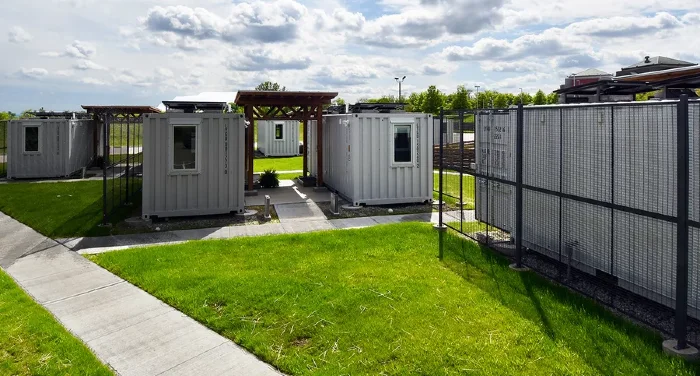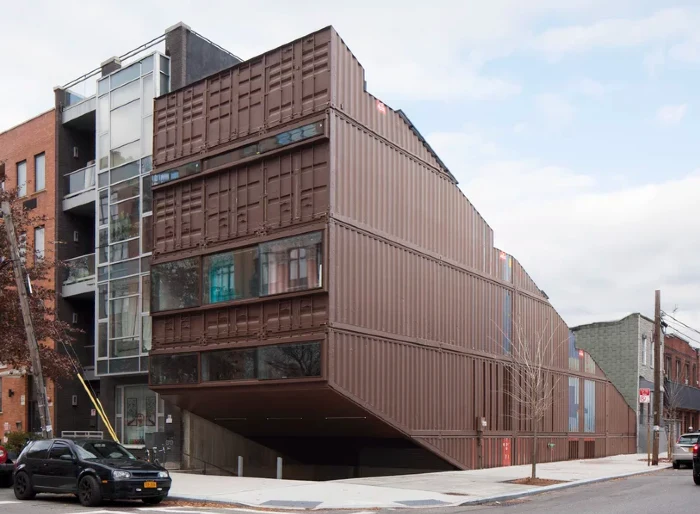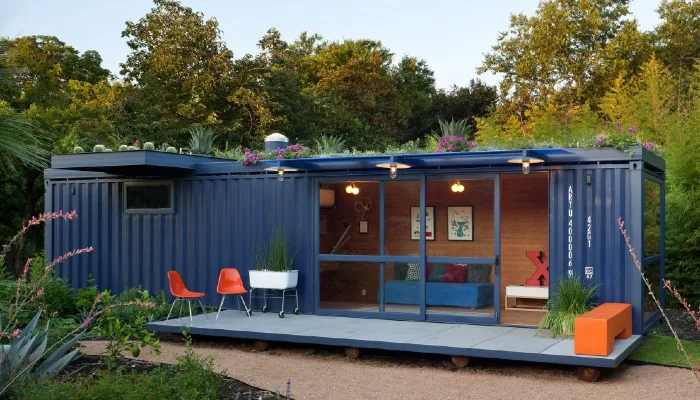In the bustling ports across the globe, millions of shipping containers lie dormant, presenting an unconventional opportunity for architects and environmentalists alike. Ada Tolla and Giuseppe Lignano, Italian architects, have tapped into this resource, using these containers as building materials and art installations.
“We found so many — it felt like something so ripe to pick, basically,” Lignano remarked during their recent visit to San Francisco for an exhibition at Hosfelt Gallery.
The concept of repurposing shipping containers isn’t new; it traces back to the 1980s (you can read more about the history of shipping container homes below). Yet, its popularity has soared in recent years, as evidenced in projects like Photoville in New York and Monarch Village in Kansas.

The appeal, as California architect Douglas Burnham points out, lies in their “modular, movable, and durable” nature, offering an alternative to traditional construction materials like cement and wood, which have significant environmental footprints.
Tolla and Lignano prefer containers that are 10 to 15 years old, blending sustainability with an aesthetic that celebrates wear and age. “Beauty can be found in things that might look ugly,” Tolla observes, highlighting the unique appeal of these structures.
However, the road to sustainable construction using shipping containers isn’t as straightforward as it appears.
Alex Rozkin, CEO of Conexwest, sheds light on the economic aspect: “When you’re building a $100,000, $200,000 structure, that $1,000 to $2,000 difference between a new container and a used container is not really significant anymore,” explaining why many opt for new containers. This preference undermines the environmental rationale of reusing old containers.

Moreover, the practicality of container homes is a subject of debate.
Architect and construction technology expert Belinda Carr criticizes the use of new containers for building, stating, “If you’re using a one-time-use container… then that container would be put to better use transporting goods across seas and oceans, which is the purpose it’s meant to serve.”
Carr also highlights the temperature regulation challenges in these steel structures, a sentiment echoed by Brooklyn restaurateur Joe Carroll, who lived in a container home designed by Tolla and Lignano. “There was no thermal heat or solar,” he said, pointing to high energy bills and environmental costs. The floors were always cold, and their heating bills were very high throughout the winter months in New York City.

You can see the Carroll’s shipping container house being built in the time-lapse video below:
So, what’s the most eco-friendly solution for these unused containers?
Mark Hogan, a San Francisco-based architect, suggests recycling them into steel studs for traditional construction, challenging the notion of repurposing them for buildings. “You’d be much better off recycling the container into steel and then build out of steel studs — like the normal way you’d build a building,” Hogan argues.
This perspective forces us to reevaluate the environmental and economic efficacy of using shipping containers in construction. While their reuse in architecture might seem an innovative solution to waste, the complexities of financial, practical, and environmental factors suggest the need for a more nuanced approach.

Of course, much of the popularity surrounding shipping containers ties into the trend of unconventional and sustainable living spaces.
According to market research, the global market for container homes is projected to grow exponentially, driven by factors like affordability, durability, and the increasing awareness of eco-friendly living solutions.
However, these financial and popularity aspects should be weighed against the practical and environmental realities.
The energy inefficiency issues highlighted by Joe Carroll’s experience with his container home in Brooklyn, where high energy bills overshadowed the initial cost savings, are a testament to the need for a holistic view of the costs involved – not just financial but environmental as well.
The Evolution of Shipping Container Homes
The story of shipping container homes is a tale of innovation, repurposing, and architectural evolution. It’s a journey that starts with a groundbreaking idea by Phillip Clark, who, on November 23, 1987, filed a patent for converting shipping containers into habitable buildings. His vision was clear: these robust steel boxes could be the foundation for affordable, modular homes.
Clark’s patent, granted in 1989, was a pivotal moment in the history of container architecture. But the seeds of this idea were sown much earlier. In 1985, the film “Space Rage” showcased shipping containers as futuristic buildings, hinting at their potential beyond mere storage.
Even before Hollywood’s portrayal, the concept was academically explored in the 1970s by UK architect Nicholas Lacey. His university thesis laid the groundwork for using shipping containers as dwellings, a vision he later brought to life with Urban Space Management.
But the roots of container architecture can be traced back even further to 1962. Insbrandtsen Company Inc., through inventor Christopher Betjemann, filed a patent for a “Combination shipping container and showcase”. This early concept, patented in 1965, envisioned containers as versatile exhibition spaces.
As these ideas simmered in the background, the concept slowly drifted into the mainstream. In 1994, Stewart Brand’s book “How Buildings Learn” discussed converting shipping containers into offices, marking the first significant literary mention of building with these structures.
The real-world application of this idea took a significant leap with the “The Simon’s Town High School Hostel” project in 1998. Here, Safmarine’s donation of forty containers to a South African high school culminated in a hostel that could house 120 people, demonstrating the practicality and scalability of container architecture.
The 21st century heralded a new era for shipping container homes. In 2006, Californian architect Peter DeMaria designed the Redondo Beach House, the first shipping container home in the U.S., setting a precedent under national building codes.
Since then, the world has seen an array of innovative container homes.
More To Discover
- Self-Healing Leather Alternative from Fungi: Could It Be Mass-Produced for Sustainability?
- Lego’s Environmental Pivot: The Company Is Facing The Harsh Realities of Sustainable Plastics And Taking A Stand Against Greenwashing
- The Future of Sustainable Soundproofing Starts With Mushrooms
- CornWall Cladding: Sustainability In The Construction Industry Using Corn Cob Waste
- The Container Guest House, built in 2010, used a single 40-foot container and featured a striking green roof.
- 2011’s Containers of Hope in Costa Rica demonstrated cost-effective construction, totaling around $40,000.
- And in 2014, the PV14 Container House in Dallas, Texas, showcased the scalability of container homes, using 14 containers to create a substantial, modern dwelling.
In conclusion, while shipping container buildings captivate with their unique blend of aesthetics, cost-effectiveness, and sustainability, the real picture is more nuanced.
Balancing the initial financial savings with long-term energy costs and environmental impact is crucial for those considering this route.
As we embrace the allure of these steel structures, we must also navigate the complex waters of their true cost – financial, environmental, and practical.



















